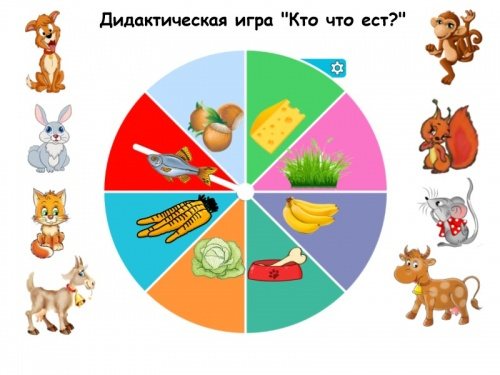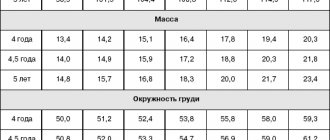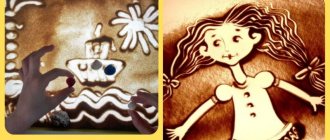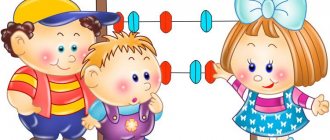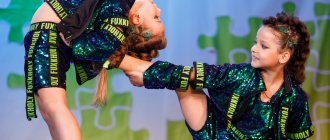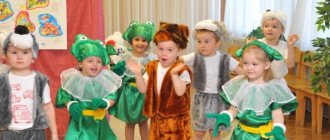The importance of classes according to the Rainbow program in kindergarten
The RAINBOW program according to the Federal State Educational Standard in kindergarten is a recommended pedagogical methodology by the Ministry of Education of the Russian Federation. It is a system of educational process with a structured and comprehensive focus.
The main audience is children from 2 to 7 years old. It involves the systematic development of students’ skills by only one teacher.
A comprehensive pedagogical project for the education and training of children was introduced into the practical environment in 1989. The methodology was developed by candidates of science, professors of the department of pedagogy and psychologists.
The RAINBOW program according to the Federal State Educational Standard in kindergarten is recommended for use in relation to children 2-7 years old
The high popularity is explained by the emphasis of younger and middle age groups on maintaining the necessary interest through cognition, creation, and playful communication. In older preschool groups - creating the necessary motivation for learning, including the presence of competitions.
The methodological values of the program are derived from the centralized idea of Russian psychology - the development of the creative personality of the child as an individual subject actively learning culture. It was from this position that the basic techniques of pedagogical influence were developed.
To organize effective work within the team, the teacher uses various types of practical activities:
- creative;
- labor;
- social.
If possible, they are concluded in a playful form.
It is interesting that the first children who studied using the method more than 20 years ago cite the Rainbow program as a fundamental aspect of creating a kind and positive atmosphere in kindergarten, which they still remember.
PROGRAM "CHILDHOOD"
In 1995, a team of teachers from the Department of Preschool Pedagogy of the Russian State Pedagogical University named after. A. I. Herzen developed the “Childhood” program. The goal of the program is to ensure the holistic development of the child’s personality during preschool childhood: intellectual, physical, emotional and moral, volitional, social and personal.
The introduction of a child into the world around him is carried out through his interaction with various spheres of life and culture. The program presents works of oral folk art, folk games, music and dance, and decorative and applied arts of Russia.
Training in the classroom is aimed at systematizing, deepening and generalizing the child’s personal experience. The number of classes and their duration are not regulated. The teacher is given the right to independently determine the need for them, content, method of organization and place in the daily routine.
The program, focused on the social and personal development of the child, fostering a positive attitude towards the world around him, includes a new important section “Attitude towards oneself”.
The content of the program is divided into four blocks: “Cognition”, “Humanite attitude”, “Creation”, “Healthy lifestyle”.
The program consists of three parts in accordance with the three stages of preschool age - junior (third and fourth years of life), middle (fifth year of life) and senior preschool age (sixth and seventh years of life).
The content is specified in sections in each part of the program dedicated to a specific age period. The logic for presenting program material in each age section is as follows:
— characteristics of the age period, achievements and prospects for the child’s development;
— features of the sphere of activity (communication, perception);
— general tasks of education;
— presentation (orientation);
— practical skills;
— levels of skill development (low, medium, high);
— methodological advice;
- recommended literature for reading, storytelling, memorization;
— recommended works of visual and musical art;
- conclusion.
To help educators working under this program, a special series of methodological literature has been prepared - “Childhood Program Library”. The manual “Plan-program of educational work in kindergarten” (under the general editorship of Z. A. Mikhailova) formulates pedagogical tasks for the main types of activities: natural history, mathematics, artistic and creative, speech, social and moral education and physical development. A brief summary presents the tasks and content of the educational process in kindergarten. The authors assume a teacher’s creative attitude to planning his work.
The “Childhood” program was approved by the expert council of the Education Committee of St. Petersburg as an original program and recommended for preschool educational institutions in the North-Western region.
Goals and principles of the Federal State Educational Standards program
The general directions of the program are revealed based on the goals of pedagogical work in a certain age group, which makes it possible to expand and modify educational techniques. The main goals of the program cover such important aspects as personal development and improvement.
In addition, Rainbow allows you to:
- Strengthen and maintain the development of healthy habits that make up a healthy lifestyle. So, children not only perform various tasks, but also remember the importance of washing their hands from used glue.
- Improve physical and psychological condition. For example, matching communication skills based on the child’s age.
- Provide the most meaningful and meaningful learning possible by broadening your horizons. For example, consideration of the topic of folk art entails familiarization with Gzhel, ancient toys and Khokhloma.
- Comprehensively prepare the child for school, including the motivational component and subsequent education. Specific knowledge that is characteristic of the educational process is addressed.
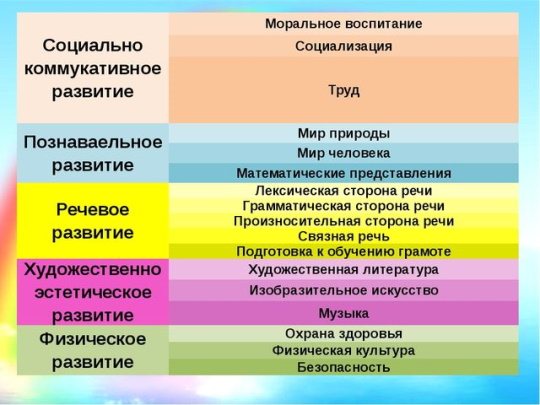
In order to realize the goals set by the child, the program offers solutions to the following tasks:
- Providing opportunities for a joyful and meaningful time in kindergarten. In this case, any cognitive activity is brought into play form.
- Improving important communication skills and speech apparatus, which is possible through alternating group and individual forms of work. This also includes communication with parents and teachers.
- The opportunity to strengthen the child’s physical condition by raising important issues such as personal hygiene and well-being. They are identified not only in the context of the organizational process, but also during games.
- Familiarization with protection issues, including training in the basics of street behavior and household safety techniques.
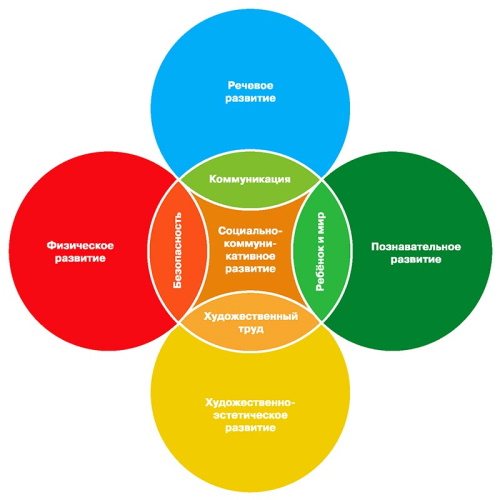
The Rainbow program allows you to solve many problems regarding the education and upbringing of children
- Providing basic knowledge about the mathematical representation of the world around us.
- The formation of respectful communication with the outside world, in particular, raises the question of the importance of helping nature.
- Introduction to knowledge, art or work. Improves general awareness of the moral side of good and evil, and also allows you to identify a person’s emotional actions.
- Improving self-control skills, including emotions, difficulties, reflection and any other aspects.
The presented programs, tasks and goals based on the age group are a mandatory component that is applied in cases of preschool organization and the introduction of an updated pedagogical program.
Federal catalog of private kindergartens in Russia
Program "Rainbow" Authors: T.N. Doronova, T. I. Grizik and others.
“Rainbow” is a comprehensive program for the upbringing, education and development of preschool children, according to which kindergartens in Russia operate. The program ensures the comprehensive development of the child; its most important components are play and physical development, the formation of habits for a healthy lifestyle, and provision of mental comfort for each child.
The program is recommended by the Ministry of Education and Science of the Russian Federation. For all main types of activities of preschoolers, sets of manuals are provided for children of various age groups and recommendations for teachers.
For classes under this program, sets of manuals for preschoolers on all types of activities and methodological recommendations for educators have been created.
The main goals of the program: providing the child with the opportunity to joyfully and meaningfully live the preschool years; ensuring the protection and strengthening of his health (both physical and mental); comprehensive and timely mental development; formation of an active and careful and respectful attitude towards the surrounding world; familiarization with the main spheres of human culture (work, knowledge, art, morality).
The content of the program corresponds, like a real rainbow, to seven different types of children's activities:
red color - physical education: during classes, habits are formed to protect one’s health, to cleanliness, neatness, order, cultural and hygienic skills and elements of self-control during movements, skills are developed for correct behavior in situations that threaten life and health, and to prevent them;
orange color - play: play is considered the leading activity of work; it allows you to provide psychological comfort and create an atmosphere of emotional warmth. security, relieve excessive organization and neuroticism in children. It allows a feeling of sympathy and interest in the playing partner to arise;
yellow color - visual activity and manual labor: - teaching visual activity and artistic labor occurs through introducing children to examples of folk and decorative arts (works of Khokhloma, Gzhel, Dymkovo toy, etc.). Children are taught to draw with pencils and paints, sculpt based on familiarity with folk sculpture;
green color - design: makes it possible to develop imagination, imagination and mentally educate the baby; children learn to build from building materials, develop constructive prerequisites, and become involved in the process of creativity in design;
blue color - musical and plastic arts classes: they allow you to develop aesthetic experiences, form an interest in music, develop the child’s musical and sensory abilities, the ability to move to the beat, spatial coordination;
blue color - classes on speech development and familiarization with the environment: learning native and foreign languages occurs through familiarization with works of folk art and fiction;
purple color - mathematics: teaching mathematics takes place in an atmosphere of goodwill, support for the child, even if he has made a mistake, the desire to express his opinion is encouraged; Children not only learn mathematics, but also master the skills of educational activities: they determine the task, the direction of the search, and evaluate the results.
The comprehensive program of upbringing, education and development of preschool children “Rainbow”, created by the team of authors from the laboratory of the Institute of General Education under the leadership of Professor T.N. Doronova is over 10 years old.
The authors managed to create a pedagogical system that allows the teacher to feel like a free and creative person and encourages an attentive attitude towards each growing child. In “Rainbow”, for the first time, the task of creating an atmosphere of psychological comfort for children in kindergarten, conditions for a joyful and meaningful experience of their preschool childhood was raised; for the first time, a system of personality-oriented education and development of children was proposed.
The program, focused on universal, humanistic values, provides for filling the work with certain content, taking into account regional characteristics. First of all, this concerns the physical development, health of preschool children, as well as their introduction to the national culture.
The work of a teacher consists of three equally necessary components: the implementation of the general tasks of mental development set in the program; the implementation of the regional component of upbringing and education; the goals of a specific educational institution and the interests of each child in the group and his parents.
The problem of preparing children for school is solved in a comprehensive manner in the program.
It includes: the development of communication skills, the development of self-care skills, familiarity with the basics of life safety, the development of children’s speech, the ability to voluntarily control the processes of attention and memory, the ability to manage their behavior in accordance with accepted rules, as well as special training implemented in classes on the formation of elementary mathematical concepts and the development of the beginnings of children’s logical thinking, initial acquaintance with letters, speech development and cognitive development.
The work process is not limited to classes and is carried out in different forms depending on the age of the children. Methods for conducting classes in various types of activities are structured in such a way that the program task can be implemented on various materials, varied by the teacher depending on and in accordance with the desires and interests of specific children. The idea that children have their inalienable rights has been introduced into the program of work in preschool institutions. The teacher’s task is to ensure that the rights of each child are respected by all other children and adults.
All of the above allowed the “Rainbow” program to become widespread in preschool institutions; it was appreciated by both parents and educators.
A set of manuals has been published under the program, including 5 manuals on the upbringing, education and development of children in each age group, 4 manuals with methodological recommendations for conducting various activities, as well as 14 manuals for children in all main areas of development: cognitive development, formation of elementary mathematical concepts, speech development, familiarity with the fine arts, design, artistic work. All manuals are recommended by the Ministry of Education of the Russian Federation.
5 methodological recommendations for educators contain methods that pursue the following goals: to form mathematical concepts in children, including through such concepts as size, color, quantity; develop active speaking skills in children, enrich their vocabulary and form a culture of speech; to acquaint children with the purposes and functions of objects, with connections between objects and natural phenomena, to give ideas about various signs and symbols; arouse children's interest in art, develop the ability to see, love and understand fine art.
The Rainbow series includes a number of manuals for children of primary, middle and senior preschool age, aimed at the formation and development of speaking skills.
Educational books “Understanding the World” for children of primary, middle and senior preschool age introduce the child to the purposes and functions of objects around us, to the connection between things and natural phenomena, to signs and symbols.
A series of educational books “My Mathematics”, ending with a book for children of senior preschool age, will help to form ideas about ways to express quantity through numbers by counting and measuring, and introduce arithmetic operations.
A whole range of educational and visual aids for children of primary, middle and senior preschool age give an idea of fine arts, folk art and children's creativity.
Didactic albums “I’ll do it myself” for manual labor classes with children of middle and senior preschool age include material on design and manual labor. Game tasks and funny characters make classes not only useful, but also exciting.
Album guides on artistic and manual labor in kindergarten and family will help develop children's imagination and ingenuity. Kids will learn to work with paper, design, embroider, weave, etc. The main focus is on making toys, characters for tabletop theater, gifts for family and friends. The book for kindergarten teachers and parents includes recommendations for organizing exciting activities in artistic and manual labor with children in kindergarten and family.
Recently, a new methodological manual was published devoted to the problems of working with children in the preparatory group “On the Threshold of School” by T.N. Doronova, T.I. Grizik et al.
Time passes, but the main values embedded in the Rainbow program remain relevant: healthy and joyful children, inquisitive, independent and open to communication with adults and peers.
Rainbow program
Authors: team of authors from the laboratory of the Institute of General Education of the Ministry of Defense of the Russian Federation under the leadership of Professor T.N. Doronova. Tatyana Nikolaevna Doronova - professor of the department of preschool pedagogy and psychology of the Moscow City Psychological and Pedagogical University, head. laboratory of preschool education at the Institute of General Education of the Ministry of Defense of the Russian Federation.
“Rainbow” is a comprehensive program for the upbringing, education and development of preschool children. The program ensures the comprehensive development of the child; its most important components are play and physical development, the formation of habits for a healthy lifestyle, and provision of mental comfort for each child. The program is recommended by the Ministry of Education and Science of the Russian Federation. For all main types of activities of preschoolers, sets of manuals are provided for children of various age groups and recommendations for teachers. For classes under this program, sets of manuals for preschoolers on all types of activities and methodological recommendations for educators have been created.
The program is based on the ideas of humanization of teaching activities, individual communication with the child, and the variable use of technology in solving program problems. The main goals of the program: providing the child with the opportunity to joyfully and meaningfully live the preschool years; ensuring the protection and strengthening of his health (both physical and mental); comprehensive and timely mental development; formation of an active and careful and respectful attitude towards the surrounding world; familiarization with the main spheres of human culture (work, knowledge, art, morality).
The program is conceived and implemented as:
- complex, i.e. covering all the main aspects of the development of children in preschool age (physical, social-personal, cognitive-speech, artistic-aesthetic);
— a personality-oriented system of upbringing, education and development of children, which has assimilated classical approaches and the main achievements of modern Russian pedagogical and psychological science. The program reflected the central idea of the national psychological school - the creative nature of development. The authors consider the child as a subject of individual development who actively appropriates culture.
The length of a child’s stay in kindergarten and the specifics of his development in preschool age require a holistic organization of his life activities, which will provide conditions for his diversified development. The “Rainbow” program is aimed at creating a holistic organization of children’s life activities in preschool educational institutions.
Program content
The authors of the program called it “Rainbow” by analogy with the seven-color rainbow, since it includes seven most important types of children’s activities and activities, during which the child’s upbringing and personality development occurs: physical education, play, visual arts and manual labor, design, music and plastic arts, classes on speech development, familiarization with the outside world and mathematics. Each section corresponds to a specific color of the rainbow, emphasizing the uniqueness of its use in working with preschoolers.
red color - physical education: during classes, habits are formed to protect one’s health, to cleanliness, neatness, order, cultural and hygienic skills and elements of self-control during movements, skills are developed for correct behavior in situations that threaten life and health, and to prevent them;
orange color - play: play is considered the leading activity of work; it allows you to provide psychological comfort and create an atmosphere of emotional warmth. security, relieve excessive organization and neuroticism in children. It allows a feeling of sympathy and interest in the playing partner to arise;
yellow color - visual activity and manual labor: - teaching visual activity and artistic labor occurs through introducing children to examples of folk and decorative arts (works of Khokhloma, Gzhel, Dymkovo toy, etc.). Children are taught to draw with pencils and paints, sculpt based on familiarity with folk sculpture;
green color - design: makes it possible to develop imagination, imagination and mentally educate the baby; children learn to build from building materials, develop constructive prerequisites, and become involved in the process of creativity in design;
blue color - musical and plastic arts classes: they allow you to develop aesthetic experiences, form an interest in music, develop the child’s musical and sensory abilities, the ability to move to the beat, spatial coordination;
blue color - classes on speech development and familiarization with the environment: learning native and foreign languages occurs through familiarization with works of folk art and fiction;
purple color - mathematics: teaching mathematics takes place in an atmosphere of goodwill, support for the child, even if he has made a mistake, the desire to express his opinion is encouraged; Children not only learn mathematics, but also master the skills of educational activities: they determine the task, the direction of the search, and evaluate the results.
In “Rainbow”, for the first time, the task of creating an atmosphere of psychological comfort for children in kindergarten, conditions for a joyful and meaningful experience of their preschool childhood was raised; for the first time, a system of personality-oriented education and development of children was proposed. The program, focused on universal, humanistic values, provides for filling the work with certain content, taking into account regional characteristics. First of all, this concerns the physical development, health of preschool children, as well as their introduction to the national culture.
The program pays great attention to protecting and strengthening the health of children and developing the habit of a healthy lifestyle. Introduction to the world of physical education begins with creating conditions for achieving an optimal level of physical activity for children in accordance with their age and individual characteristics. One of the central points of the program is the development of a personality-oriented style of communication between an adult and children in accordance with the specifics of each age group. The authors of the program imply that educators understand and accept the concept that children have their inalienable rights. The teacher’s task is to ensure that the rights of each child are respected by other children and adults. This develops in children a sense of self-esteem, security, equality and, on this basis, potential goodwill towards peers and adults. Attitudes towards peers are formed in the course of purposefully organized by the teacher age-appropriate joint activities of children, aimed at obtaining a common result that is necessary and interesting for its participants. An atmosphere of goodwill is created by introducing good traditions of group life: joint holidays, leisure activities; sympathy and mutual assistance; hospitality, etc.
Work under the Rainbow program is carried out in various forms of organizing children's activities, taking into account the age and individual characteristics of children and types of activities. The tasks set in the program are also implemented in so-called everyday learning situations, during routine moments. Game forms and methods of teaching and consolidating acquired knowledge are widely used. Great importance is attached to the independent cognitive and productive activities of children. The work of a teacher consists of three equally necessary components:
implementation of the general tasks of mental development set in the program
implementation of the regional component of upbringing and education
the goals of a particular educational institution and the interests of each child in the group and his parents.
The problem of preparing children for school is solved in a comprehensive manner in the program. It includes:
development of communication skills,
development of self-service skills,
familiarization with the basics of life safety,
development of children’s speech, the ability to voluntarily control the processes of attention and memory, the ability to manage their behavior in accordance with accepted rules,
as well as special training implemented in classes on the formation of elementary mathematical concepts and the development of the beginnings of children’s logical thinking, initial acquaintance with letters, speech development and cognitive development.
The work process is not limited to classes and is carried out in different forms depending on the age of the children. Methods for conducting classes in various types of activities are structured in such a way that the program task can be implemented on various materials, varied by the teacher depending on and in accordance with the desires and interests of specific children. The idea that children have their inalienable rights has been introduced into the program of work in preschool institutions. The teacher’s task is to ensure that the rights of each child are respected by all other children and adults.
A set of teaching aids has been developed for the Rainbow program to effectively develop and educate children in kindergarten. Methodological support for the program includes manuals and books of various types. They are interconnected and complement each other.
Advantages and disadvantages of the program
The RAINBOW program according to the Federal State Educational Standard in kindergarten is a pedagogical technique that is quite popular.
In practice, one can highlight the objective advantages of its implementation:
- Full psychological and physiological development. Through various activities, children acquire necessary information, including the ability to focus physical energy in useful ways. This is how high-quality preschool education occurs.
- Techniques that allow maximum implementation of a personal approach to each child, which is possible thanks to the differential assimilation of program issues.
Thus, the teacher has the opportunity to change the content of the technique in such a way that children with the required level of development acquire a little more previously indicated information. At the same time, a child with missing knowledge can improve the level of his own development and bring it to the required values.
- Drawing up a visual and formative environment with the aim of creating a positive atmosphere within the group, maintaining internal confidence in children, as well as creating conditions for success. In this case, material and technical features do not play any role.
The teacher independently approaches the selection of the necessary materials that are used for pedagogical purposes. For example, when developing sensory abilities, the teacher does not buy ready-made props, but produces them himself: an empty box filled with coins, small toys, sugar, and much more.
- A high-quality approach to the analysis of activity is not from the psychological side “a child should”, but from the “a child at this age is capable of...”. At the same time, value judgments include not only practice, but also the process of communication and observation.
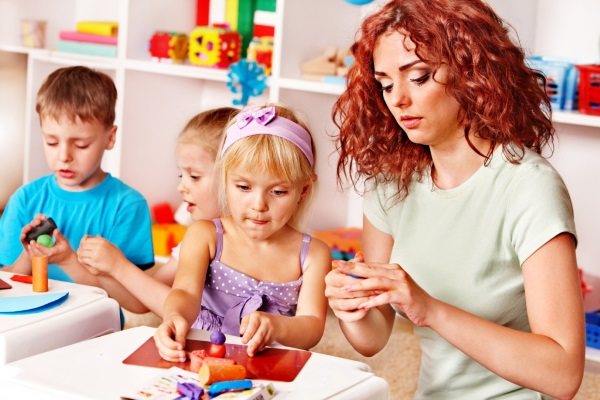
Like any other program, the “Rainbow” method has a number of disadvantages, which in some cases may not suit the teacher. The technique cannot provide accurate installation without the use of additional tools.
It is assumed that the teacher is not only a performer, but also a creator : each child has a number of abilities that can be revealed using techniques or methods. The mechanism is especially difficult to implement for most educators, especially young and inexperienced ones.
As practice shows, some of the techniques being carried out are complicated, which is associated with the simultaneous publication of new additions and the experimental implementation of the program in the pedagogical environment.
Therefore, many of the wishes of kindergartens were not taken into account when they were first launched, including the not-so-objective ratio of age categories to the expectations of parents.
Techniques of the Rainbow program
Based on the age of the child and the types of activities involved in the program itself, “Rainbow” is distinguished by 4 main groups of techniques that are most effective with an integrated approach.
Visual
Visual-figurative thinking is a fundamental type of consciousness of preschoolers, which forms the child’s aesthetic understanding and supports a more solid assimilation of new information. Therefore, the presence of visibility at all stages of the lesson is especially important.
In pedagogical practice, the following techniques are used that develop imaginative thinking:
- Images. The technique is especially relevant for junior teams. For example, with its help you can familiarize your child with the need and importance of hygiene after a walk (washing hands, feet, washing). It also allows you to develop a sequence of everyday actions (putting personal belongings in the children's closet, tidying up the bed).
- Observation. An organizational method of cognitive activity that makes it possible to get acquainted with a certain phenomenon using the senses.
Thus, by observing the environment, a child can gain an understanding of how living organisms are created. A good example is that children gather around a bowl of water, into which the teacher drips vegetable oil. After which the process of observing how the drops begin to unite, forming one common blot, occurs.
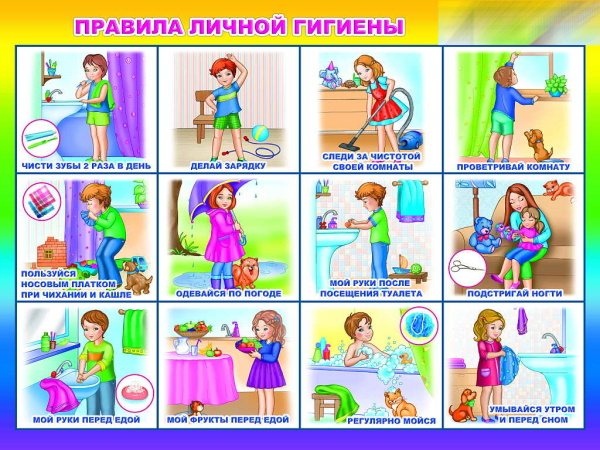
One of the techniques of the Rainbow program is a visual demonstration of the material (for example, teaching children hygiene in pictures)
- Demonstration. The technique is characterized by the display of various photographs and video materials, as well as staged scenes, with the help of which children are taught the properties of objects or individual phenomena.
For example, in order to teach a child how to properly collect snow from the yard, the teacher shows small slides, simultaneously explaining how to properly rake snow and hold a shovel.
The visual method contributes to the formation of important qualities in the child, with the help of which he begins to trace the relationship between various phenomena, thereby increasing his overall observation ability.
Verbal
Since the speech apparatus cannot develop without the use of active listening techniques, the Rainbow program suggests including the child in dialogue from preschool age:
- Conversation. Allows you to get to know the child much better, including his interests and inclinations. By creating their own group communication techniques, teachers can collaborate most effectively with children.
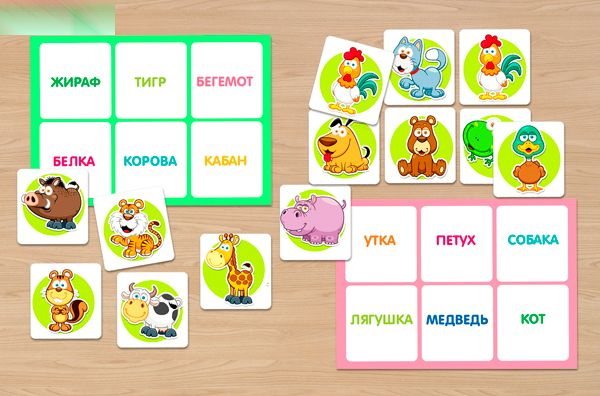
Thus, using one of the “Circle of Communication” methods, upon arrival at kindergarten, children begin a dialogue with what they learned about yesterday and what they want to learn Today. Often such communication is complemented by gymnastics and board games.
- Story. Often used to increase motivation at the very beginning of a lesson. For example, in a lesson you can talk about Dunno, who received an assignment from Button to water the flowerbed that has the most plants. Thus, children learn quantitative comparison of objects.
- Riddles and poems. Using this technique, the teacher not only develops the logical thinking of children, but also sets them up for further interaction and trains their thinking speed. If the younger group often uses puzzles with sayings, then the older group uses simple logic problems.
- Fairy tales. This technique fits well into the concept of speech development, expanding vocabulary and developing emotional openness in children. With the help of fairy tales, the teacher is able to motivate the child by explaining certain concepts (for example, in order to explain why it is important to always tell the truth and not be embarrassed by others).
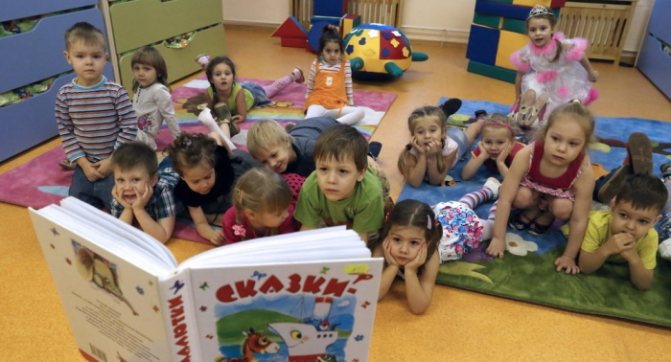
Reading fiction aloud is one of the most effective techniques for teaching children
- Reading. This is a good method that allows you to develop initiative in children - to feel their own importance in the team. Such reading is determined not so much by the quality of the text, but by the improvement of skill. Whether it's a personal hygiene guide or a magazine clipping. Reading must be done out loud.
When working with a younger group, the teacher must intentionally create various situations in which children need to look for and pronounce words. For example, if a child points his finger at the desired object, the elder should make a look of incomprehension until the baby says what he wants - at the minimum accessible level.
Playful and practical
The RAINBOW program according to the Federal State Educational Standard in kindergarten defines games as the leading type of activity, which, together with other techniques, makes it possible to achieve good results in learning.
Examples of popular games in preschool educational institutions:
| Age category | Game type | Name | Target | Carrying out |
| I junior group | Mobile | "We and Soap Bubbles" | Development of positive emotions in the group. Helping a child with long-term adaptation to kindergarten. Relieving tension between children. | The teacher releases numerous soap bubbles while reciting any funny poem. Children catch them, share their own impressions and emotions. |
| II junior group | Didactic | “Who eats what?” | Strengthen existing understanding of the food of the animal world | Children take out vegetables or fruits from a common bag. Each child must identify what the item is and say which animal consumes it.
|
| Older | "One is many" | Teach the creation of plural nouns | The main instrument is the ball. The teacher refers to singular noun objects, after which the ball is thrown. The child must name the plural of the object. | |
| Average | Story-based with role-playing inserts | "Our favorite kindergarten" | Improve knowledge about the main purpose of the kindergarten and the professional activities of the people who work in it - nannies, cooks, teachers. Nurturing a child’s motivation to imitate good qualities in adults. | Use existing toys that fit the play theme. After offering to play in kindergarten, the teacher chooses a profession for each child. During the game, it is necessary to monitor the relationships between children, and, if possible, give hints and help get out of difficult situations. |
Gaming techniques are closely related to practical ones, which include applications, drawings, projects and fakes. With their help, the child gets to know not only himself, but also the world around him - the kindergarten as a whole, and other children.
Symbolic
The most popular technique used by almost all preschool educational institutions in the new school year is the creation of a common panel “Mountain of Gems.” The essence of the technique is to figuratively apply the colors of the rainbow, which symbolize the main area of the Rainbow program - knowledge and improvement.
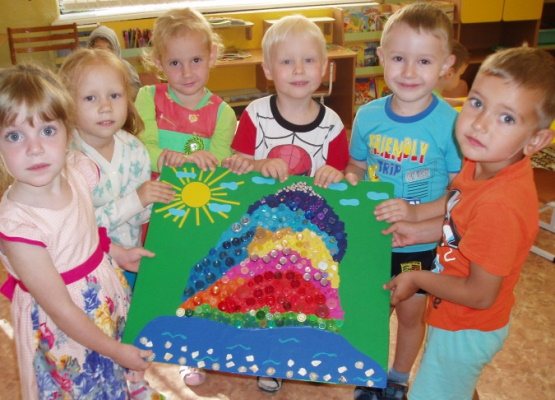
Panel “Mountain of Gems”
So, each of the children brings bright buttons, beads or beads from home, which are subsequently used to decorate the painted mountain. The task is performed in a group format. Upon completion of the project, the picture is shown to parents and teachers. Over the next year, the craft decorates the interactive corner of the kindergarten.
Organization and conduct of classes at preschool educational institutions
The RAINBOW program according to the Federal State Educational Standard in kindergarten is carried out within the established time frame, which is calculated based on the requirements for various age categories:
- I and II junior groups: 15-20 min.
- Middle group: 25 min.
- Preparatory and senior groups: 35-40 min.
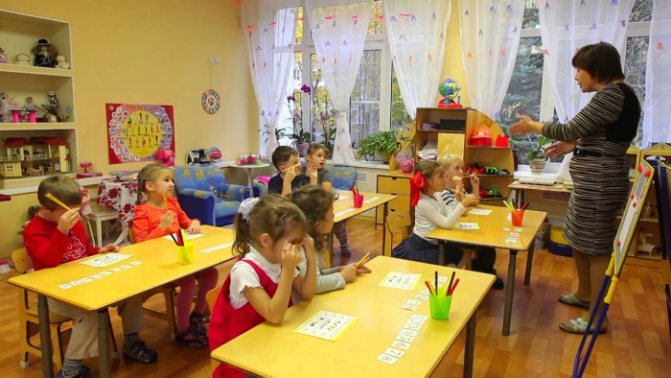
Practical and technical elements of classes are adjusted to the given timing:
- Preparation (3-5 min). Introducing children to the topic through motivation and updating the given information - images, riddles and puzzles, demonstration presentations.
- Main block (20-25 min.). Characterized by familiarity with the presented material, including its processing and analysis, creative perception of information.
The main stage includes physical exercises, games and communication with children. Based on the characteristics of the block, children are taught independent activities, if possible - the teacher practically does not help, only observational activities.
- The final block. A value judgment is given to the whole group and to each child individually. It is important to say approving words that will motivate children to further activities. In the older and middle age categories, work is assessed by the children themselves.
An example of a summary of a mathematical lesson on “Rainbow” in the 2nd junior group.
| Stage | Description |
| Introduction | The teacher brings a small toy snowman on a sleigh, after which everyone takes turns examining its rounded shape. The snowman says to the children: “It’s kind of lonely and boring for me to walk around the yard, clean the paths, and remove the snow. I want snowman friends. Children, help me! The teacher asks the question: “Guys, let’s help the poor snowman?” The students respond positively. |
| Main block | The teacher begins a demonstration of what a snowman can be made from: tracing with his fingers, he shows circles and talks about the lack of angularity. After which the teacher invites each child to roll the circle with his own hands and understand its structure. Questions asked: “Indicate the largest and smallest circles.” “What do we call the shapes that make a snowman?” After the answers, the teacher conducts a short warm-up, which is accompanied by poems or songs about a snowman. The teacher invites the group to a table on which there are paper circles of different sizes. Children make friends for the snowman. The work takes place independently with possible assistance. If desired, new objects are added, eyes, nose, hat or broom are drawn. |
| Final block | Each of the children gives the snowman a new friend. After which the toy thanks the guys for the completed task. Final question to the children from the teacher: “For whom were snowmen made?” “What were they made of?” |
A game like this not only introduces three-dimensional bodies (cone, circle, cylinder), but also strengthens gluing skills, develops motor skills, and teaches children the important skill of perseverance, motivating them to finish what they start.
Evaluation of program results
The RAINBOW program, like any other system technology, requires an evaluative judgment according to the Federal State Educational Standard, thanks to which the teacher can evaluate the work of children.
The analysis of the methodology carried out in kindergarten is characterized by 3 steps:
- Implementation of a plan. The percentage and numerical ratio of children who have mastered the essence of the program based on educational activities.
This is indicated by medium and high levels of completion, which are calculated from the time spent on a task. Based on the analysis, children who need more attention from parents and teachers are identified.
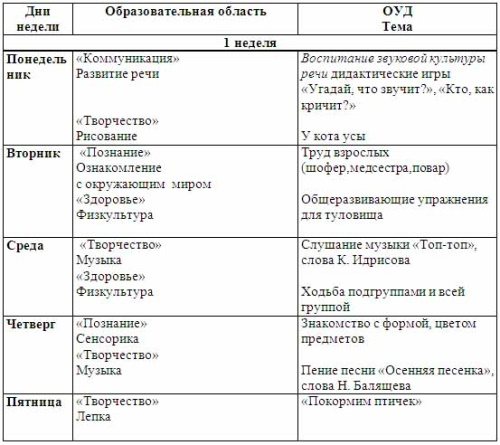
Analysis of the results of the Rainbow program is carried out based on the implementation of the lesson plan
- Program analysis , which involves a value judgment within a certain scale (low, medium and high). Takes into account the execution of tasks based on the program areas used.
- Description of the analysis. Performance on tasks in each thematic area is indicated. Percentage judgment of low, medium or high scores is applied.
Future prospects and predisposition to certain skills are described. Implementation deficiencies are examined and corrected in the next lesson.
Of all the available pedagogical complexes with interesting techniques, the RAINBOW program, developed in accordance with all Federal State Educational Standards standards, is in the highest demand. A preschool teacher must have a creative, individual and fair approach to each child.
Basic variable programs
Variative and alternative programs are distinguished by their philosophical and conceptual foundations (the authors’ views on the child, on the patterns of his development and, accordingly, on the creation of conditions conducive to the formation of personality).
Variation programs can be basic or additional.
Main programs:
The content of the main program meets the integrity requirements, i.e. includes all the main directions of development of the child’s personality: physical, cognitive-speech, social-personal, artistic-aesthetic, and contributes to the formation of the child’s versatile abilities (mental, communicative, regulatory, motor, creative), the formation of specific types of children’s activities (subject, play, theatrical, visual, musical, construction, etc.) Thus, the main program determines the entire range of developmental tasks (including correctional tasks) and all meaningful aspects of educational activities in preschool institutions as part of the implementation of basic educational services. The main comprehensive preschool education programs include: “Harmony of Development”, “Kindergarten - a House of Joy” and “Childhood”. , “Childhood”, etc., etc.); “Golden Key” (etc.); “Origins” (ed.), “From Childhood to Adolescence” (ed.), “Baby” (etc.); “Program of education and training in kindergarten”; “Program for short-term stay groups in kindergarten: senior preschool age”; "Rainbow"; "Development".
As part of the implementation of the main educational activities of preschool educational institutions, specialized programs can be used: “Beauty”. Joy. Creativity" (etc.); "Dewdrop. In the world of beauty"; "Piece of art"; "Nature and Artists"; “Adjustment fork”; "Harmony", "Synthesis"; "A little boy"; "Musical masterpieces"; "Rhythmic mosaic"; “Program for the development of speech for preschool children”; “Program for the mathematical development of preschoolers in the School-2000 system”; "Dewdrop. Grow healthy”, etc.
Among the basic programs, a special place is occupied by correctional programs (in areas of correction), the implementation of which involves a number of necessary changes in the organization of children’s lives, adaptation of the standard regime and the creation of a special subject-development environment of the preschool institution.
